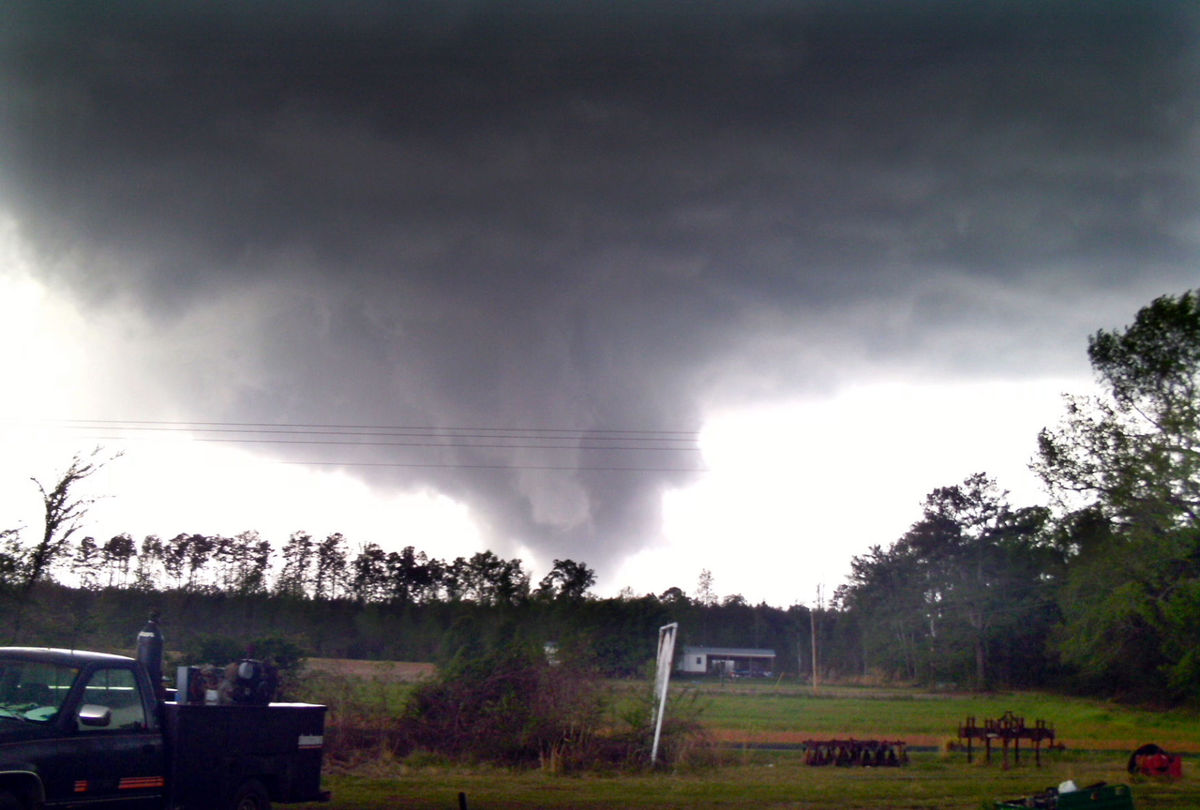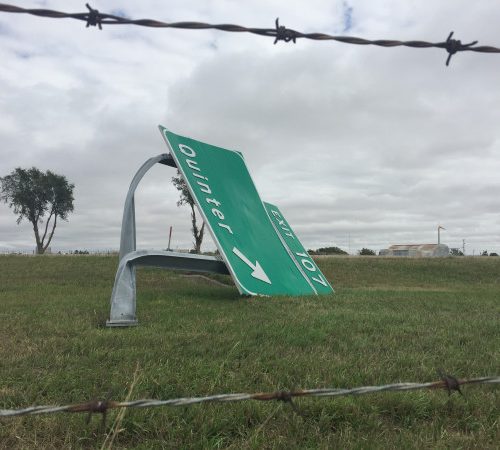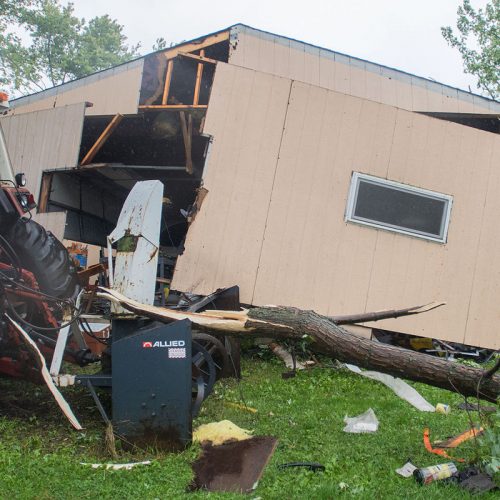Ashley Deyo didn’t have time to be scared.As co-workers shouted and frantically waved her into the saving shelter of the Lowe’s Home Improvement store in Sanford, only three thoughts filled her mind:
Get inside.
Call the folks.
Don’t look back.
“I’m sure I was scared,” Deyo said five years after the April 16, 2011, storm. “I don’t really know. There was too much going on.”
On her heels was a mile-wide rolling ball of destruction, part of a 16-state tornado outbreak that weekend. A total of 38 people were killed across the country, eight in the Cape Fear region and 24 total across North Carolina. Hundreds were injured.
More than two dozen twisters touched down in the state, none more powerful than the ones that plowed through north Fayetteville and Sanford in Lee County. About 2,500 homes in the region were destroyed or damaged, as were about 200 businesses.
Five years later, the only lingering legacy in many places is a lack of tall trees. Just about everything else has been rebuilt as good as new, or better.
In other places, old landmarks have given way to newer buildings and new dreams to replace the nightmares that lingered too long for others.
Some spots never came back, like the dreams and hopes were scoured from the land and scattered in the roar of wind.
It had already been a sort of strange day at Lowe’s Home Improvement. Although mid-April is usually one of the busiest times at the store, morning showers had kept some customers away.
Store manager Mike Hollowell had asked head cashier Lana Morris to close the gardening section because of the rain.
“Then the sun came out,” Morris said. “So we were open again. But later, someone mentioned another storm was coming. I stepped out front to see.”
What she saw was a wall of cloud and debris that had chewed through the nearby St. Andrews Church Road neighborhood minutes earlier. The storm continued in a near-straight line and was beginning to peel back the roof of a Tractor Supply Co. and Big Lots across South Horner Boulevard.
She also saw Deyo, a first-year cashier at the store, and a couple of customers trying to outrun the storm.
Lowe’s employee Mandy Vanderroest remembers seeing something else.
“We started trying to get everyone inside, but it was hard,” she said. “A lot of people kept stopping to turn around and take pictures with their cameras.”
Employees began shepherding customers to the back of the store, where there were no windows and walls were stronger.
Then, Morris said, the store went pitch black – a darkness punctuated by shouting, the store’s piercing alarm system and the roar of wind.
“People say it’s like a train,” Deyo said. “It was more like a jet plane, right over your head.”
Most people made it to the back, receiving only bumps and cuts. Vanderroest had to hunker down in a nearby hallway, hanging on to a metal pole cemented to the floor.
Surprisingly, the only part of the store to escape destruction was the garden center.
“That’s how we got out,” Vanderroest said. “The hanging plants were still there. Everything else was a mess.”
Lowe’s immediately announced plans to rebuild. Employees were offered work at neighboring stores through the summer. The store reopened in September 2011, about 140 days after it was torn apart.
By the end of 2012, many of the neighboring stores damaged by the storm were back, as well.
The new store has a small shrine dedicated to that day. The American flag flying over the store, found in the rubble, has been saved and hangs inside the building.
Several employees either worked at Lowe’s or lived in the area in 2011. And they all remember.
“We had a tornado warning in Lee County last month,” Morris said. “Two local families who lived in mobile homes drove here asking if they could stay until the storms passed.
“We set them up inside. It’s kind of an honor that people think of us as a place of safety.
“I just hope we never have to go through anything like that again.”
A total of eight tornadoes, some packing winds of up to 140 mph, raked the region. One person died in Cumberland County, seven more in the Cape Fear region. There were about 300 injuries.
Had the storms hit a day earlier, churning up Yadkin and Reilly roads as hundreds of cars were leaving Fort Bragg and buses of kids were leaving Pine Forest High School and Ben Martin Elementary, things would have been much worse.
But it was the lack of a school bus that may have saved several children at Ben Martin. James Autry, a science teacher at the school on Reilly Road, said on that day – a Saturday – he was coaching a group of students in a regional science competition.
“We were going to take a school bus there and back,” Autry recalled. “If so, we probably would have been getting back to the school at about 4 p.m. All the kids would have been right in the middle of the tornado.”
The tornado that ripped through north Fayetteville, like the one in Sanford, was an EF-3 storm with top winds near 140 mph. It had formed in rural Hoke County, near Wayside, and strengthened as it crossed the LaGrange and Summerhill subdivisions, blasting across Yadkin Road and into the Cottonade neighborhood.
As it reached Reilly Road, it was a huge, muddy blob of roaring wind – not the sort of thing John Burke expected to see.
Burke was the manager of the Reilly Road Farmer’s Market. He knew that storms were expected in the region that afternoon, but when the store’s cashier said something was coming, “it didn’t look like a tornado to me,” he said. “You know what they look like on TV, those long roping things.
“This was a wall of darkness, with all sorts of noises coming out of it. Then I saw the U-Hauls flipping from the place down the street and said, ‘We’d better get down.'”
Quick thinking by the staff got everyone safely in the bathrooms just as the storm hit. Everything else was smashed.
“We never did find one of our signs,” Burke said. “Lord knows where it ended up.”
Across the street, the storm pummeled the kindergarten wing of Ben Martin Elementary and peeled the roof off elsewhere. The school still has scars, cracks in the walls where the storm lifted part of the building and slammed it down again.
Thankfully, Autry’s Science Olympiad team caught rides to the event with parents or friends, rather than meeting at the school.
“Driving back into town, the sky had that tell-tale greenish color,” Autry said. “Then I started hearing the reports on the radio.
“I had a four-wheel drive vehicle, and it still took me more than an hour to get the last mile into school,” he said. “I ended up cutting through a yard to get around to the back.”
The damage at Ben Martin shuttered the school for the rest of the year. Students were shuttled to other schools for the rest of the spring.
A rooftop weather system Autry had installed years earlier was lost in the wind.
“We still have the readings up to the point it vanished,” he said. “There’s a huge pressure drop, then nothing. Maybe someone will find it in the woods someday.”
People who lived in the storm’s path have two overpowering memories: The smell of pine, and the number of strangers who showed up to help.
Staff Sgt. Patrick Jacobson and his wife, Shannon, lived on Brunswick Road in Cottonade. When the storm hit, Shannon scrambled to get in a hall closet.
“It seemed like an eternity until the wind stopped,” she said. “Our house was missed by inches from our neighbor’s pine trees. My car was impaled from another pine tree.
“A barber shop sign from Yadkin Road was stuck in my neighbor’s tree. Another neighbor’s trash can was about 30 feet up in a tree.”
Since the couple were uninjured, they began walking the neighborhood, offering help. In the days that followed, others joined in.
“Our neighbor’s church came and fixed our roof,” Shannon said. “The Red Cross brought us lunch and dinner. People we did not know drove around passing out drinks, burgers and hot dogs off of the back of a truck. My brother came from Fuquay-Varina with his dump truck and helped clear trees.”
There also were rip-off artists and some looters. Neighbors joined together to guard property for days.
“All in all, you remember the people who helped,” said Burke, the manager of the Reilly Road Farmer’s Market. “The others will have to answer for what they did eventually.”
Five years later, many of the homes and businesses that were destroyed have returned.
Some haven’t. Every area hit by the storms has a gap-toothed grin, an empty lot or patch of concrete where a building used to be.
“A lot of people didn’t have the right kind of insurance,” Burke said. “When it came time to rebuild, they weren’t covered.”
Others had less than enough coverage. Homes originally insured in the 1960s for a fraction of their value became empty lots. Many rebuilt, then faced skyrocketing property taxes.
On Fort Bragg, the base riding stables and trails were badly damaged. Eventually, officials decided it would make more sense economically to shut them down.
In a few cases, people had the money, but just didn’t have the heart to start again. Property was sold, and older owners moved away to live with family elsewhere.
“There are a lot of people we used to see here before the storm,” Burke said. “They just aren’t here anymore. They moved on.”
Some of the disappearances were personal. Of the 24 people killed in the state, eight died in the Cape Fear region, all in vehicles or mobile homes. Two died in Lee County, near Broadway. Another died in Linden in Cumberland County. Four died amid the wreckage of mobile homes near Ammon in Bladen County.
Another died on the east side of Dunn, in what used to be a mobile home park with more than 100 residents.
Today, only the concrete entries and a “property for sale” sign mark the Cedar Creek Mobile Home Park. The property was cleared after dozens of homes were destroyed.
Just to the south, the last large remaining monument to that day’s fury is about to come down. The Alphin Bros. Seafood Warehouse, rendered unusable after a tornado ripped its roof away, is scheduled to be leveled by the end of the month.
The warehouse sits next to the Food Lion Distribution Center off U.S. 301, which also was heavily damaged.
It took a year for the distribution center to recover. The Alphin Bros. facility never did. As worries about asbestos and lead paint delayed action, the battered red-and-white building reminded passersby of the storm’s power.
Finally, in early April, a local company was given the OK to demolish the 70,000-square-foot structure.
“The building will be torn down and hauled away,” said Henry Elmore of American Earthworks. “It’s been a long time coming.”
And, in time, only memories will remain.
Things are different now. Ben Martin Elementary has fewer students than it did in 2011. Business is a bit slower at the businesses along Reilly Road that rebuilt.
“Things just aren’t the same,” said Burke at the Reilly Road Farmers Market.
The final economic toll in Cumberland County was estimated at $100 million.
On Yadkin Road, where more than a dozen businesses were destroyed, new buildings have popped up next to still-barren lots. Many of the homes in parts of LaGrange, College Lakes, Summer Hill, Cottonade and Fairfield Farms have new roofs. Nearly all have new trees, as well, dozens of small dogwoods replacing long-gone pines.
The Jacobsons stayed in Cottonade.
“Our lives were back to normal in less than two weeks,” Shannon said. “But I know some that it took months – and others that moved and did not come back.”
The experience in Sanford led Lowe’s officials to revamp portions of the company’s emergency protocol. Decision-making in the wake of local disasters is more streamlined, after the chaos that followed there.
“I got a call afterward from a region manager,” said Mandy Vanderroest, one of the ranking officials at the store. “He said, ‘I hear you’re having a bad day down there.’
“I told him, ‘You could say that … I don’t have a store anymore.'”
Across the region, memories linger and are stirred quickly when clouds gather and the sky takes on a certain look.
“The kids here, even the ones who were still too young for school, remember,” Autry said. “And the ones that were here pay a lot more attention when we’re teaching weather.”
Lana Morris agrees.
“When the wind starts blowing, I look to the sky,” the Lowe’s employee said. “I can’t help it.
“Then I look around and there’s always someone else looking, too. I think, ‘Yep, they must have been around the day the tornado came.”
Staff writer Chick Jacobs can be reached at jacobsc@fayobserver.com or 486-3515.
Damage at a glance
On the afternoon of April 16, 2011, it took only a short time for tornadoes to wreak havoc throughout the state. These are damage estimates for the hardest hit counties in the Cape Fear region.
FAYETTEVILLE
Damage: $43.65 million
Homes destroyed: 120 single-family homes, 24 multi-family homes
Homes damaged: 1,336
Businesses destroyed: 26
Businesses damaged: 62
Debris collected: 142,195 cubic yards of vegetative debris and construction and demolition debris; 1,580 cubic yards of household hazardous waste
Cost of debris pickup: $2.9 million
Number of homes that have been abandoned since the storm: Nine
CUMBERLAND
Deaths: One
Damage: Approximately $100 million throughout the county, including Fayetteville
Homes destroyed: Unknown; several in Linden and Beaver Dam
Homes damaged: More than 100
Businesses destroyed: None in the county
Businesses damaged: One
Debris collected: 4,738 cubic yards
Cost of debris pickup: None for the county; the state Department of Transportation provided the pickup.
BLADEN
Deaths: Four
Damage: $3.78 million
Homes destroyed: 25
Homes damaged: 100
Businesses destroyed: None
Businesses damaged: Two
Debris collected: 1,640 tons
Cost of debris pickup: $73,700, paid for by N.C. Department of Transportation and reimbursed by the Federal Emergency Management Agency
HARNETT
Deaths: One
Damage: $14.7 million
Homes destroyed: 40
Homes damaged: 40 with major damage; 96 with minor damage
Businesses destroyed: One
Businesses damaged: One with major damage, 12 with minor damage
Debris collected: 50,000 cubic yards
Cost of debris pickup: $936,000, picked up and paid for by N.C. Department of Transportation and reimbursed by FEMA
LEE
Deaths: Two
Damage: $3.1 million
Homes destroyed: 120
Homes damaged: 480
Businesses destroyed: 18
Businesses damaged: 51
Debris collected: 93,122 cubic yards
Cost of debris pickup: $925,000 paid by the county, to be reimbursed by FEMA
By Chick Jacobs Staff writer




